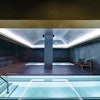More schools are realizing that student health and student recreation can be compatible cohabitants under one campus-wellness roof.
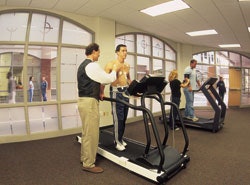 TEST TAKERS Anderson University students undergo heart health evaluations inside the Kardatzke Wellness Center.
TEST TAKERS Anderson University students undergo heart health evaluations inside the Kardatzke Wellness Center.Vibrant student recreation centers have become mainstays of contemporary college campuses. So have health-conscious students. To take full advantage of these trends, many institutions are merging their recreation center and student health center into a single facility. Call it a one-stop campus shop for enhanced student wellness.
Merged departments benefit from cross-programming opportunities and synergies inherent to cohabitation. Student recreation, which typically aids campus recruiting, retention and overall quality of life, also provides students with the opportunity to form lifelong healthy living habits. Student health deals primarily in curative healthcare, often including psychological, social and emotional counseling as program offerings. Direct association between the two entities affords the opportunity to reach the campus population in a wellness mode - before curative medicine is necessary.
This mirrors a similar and growing dynamic in community-based healthcare and wellness facilities. In 2003, Healthcare Design noted that wellness center trends in the community marketplace "are general health-consciousness movements, along with reimbursement-driven incentives, to keep people healthy." These wellness centers typically provide the additional resources and motivational assistance necessary to help individuals reach health and wellness goals. The same can now be said of an increasing number of campus recreation centers, starting with their core programs in recreation and health.
What is wellness? It is a state of optimal well-being oriented toward maximizing an individual's potential. Specifically, it involves a lifelong process of achieving well-being in at least six commonly identified dimensions: physical, intellectual, emotional, social, spiritual and environmental. Many promote this as a lifestyle requiring personal responsibility and a willingness to make ongoing healthy choices. The World Health Organization (way back in 1948) defined this lifestyle (then called health) as ". . . a state of complete physical, mental and social well-being, and not merely the absence of disease or infirmity."
Wellness is a holistic approach to health maintenance and improvement, as opposed to waiting for people to become sick and then treating their sickness. The concept is simple, according to Healthcare Design: "With exercise, information and education, people increase their chances to lead healthier and more independent lifestyles."
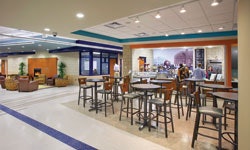 DIET AND EXERCISE Healthful food options greet visitors to The Leonard Center at Macalester College.
DIET AND EXERCISE Healthful food options greet visitors to The Leonard Center at Macalester College.Integrative medicine - a growing field of medicine in which patients and providers work together to develop a diagnostic and therapeutic program, drawing on a variety of traditions, expertise and modalities - also plays a part in the pursuit of wellness. According to WebMD, IM "depends on a partnership between the patient and the doctor, where the goal is to treat the mind, body and spirit, all at the same time."
This multidisciplinary approach and broader treatment options dovetail perfectly with the services provided by campus recreation professionals, who can leverage their specialized knowledge and resources to provide maximum therapeutic value for students. For campus healthcare providers, a merger provides staff and patients with immediate access to athletic or intramural activity spaces, larger physical therapy facilities and significantly larger fitness and weight rooms, thus reinforcing their programs and the benefits of lifelong activity and exercise. This is in keeping with the "Standards of Practice for Health Promotion in Higher Education," released in 2004 by the American College Health Association. (Consider the top five impediments to academic performance for college students, and the correlating benefits of regular exercise in the chart below.)
Moreover, college recreation programs often are intertwined with a variety of academic pursuits - everything from athletic training to biomechanics research to exercise physiology - that also offer opportunities for synergy. Forward-thinking recreation and health program providers find ongoing opportunities for connection to the campus population, expanding their reach in beneficial ways (see "Get Smart," below). These programs range from professional information-oriented fairs to facilitated education classes, and from simple but informative wall displays to outpatient medical testing. Relevant partnerships can also take the form of onsite pharmacies, massage studios, and retail space offering fitness products and therapeutic goods.
Perhaps the most intriguing application of these kinds of shared services is currently in design on the University of Colorado Denver Anschutz Medical Campus, where the objective is to establish a synergistic relationship between existing programs in human nutrition, integrative medicine and women's health research while enhancing student fitness, health, research and lifestyle management. Supporting these specific disciplines and goals will be outreach and education spaces, a demonstration kitchen, a healthful food café/bistro, a fitness center, a therapeutic pool and a healthful food market - all complemented by a 10-room, short-stay hospitality venue.
Functionally, student health centers make for good roommates. On many campuses, these densely packed medical facilities function efficiently within 4,000 square feet (depending on the number of practitioners and the overall service population) - less space than is consumed by a small gymnasium, or just five racquetball courts.
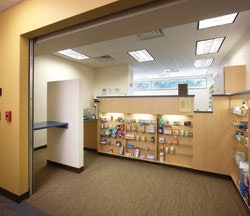 FILLING STATION South Dakota State University's Wellness & Student Health Center offers the convenience of an in-house pharmacy.
FILLING STATION South Dakota State University's Wellness & Student Health Center offers the convenience of an in-house pharmacy.Minimal program requirements dictate that space be allocated for universal-size exam rooms, a treatment room, a nurses station, a phlebotomy area, an immunization cubicle, a small patient laboratory, secure medicine storage, clean/dirty linen storage, restrooms, offices for medical professionals, a records management room, a billing and administration processing area, and a patient waiting area. Recreation spaces that student health practitioners can share typically include an entry foyer/lobby, a large interior rotunda/centrum, classrooms, group exercise rooms, weight training and cardio fitness rooms, and smaller gymnasiums. All of these spaces can support diverse programming needs while considerably increasing the exposure of the student health operation.
Issues of functional space design within the actual health center are critical. First, there are the medically driven health code requirements to keep dirty resources from contaminating clean ones. Second, medical practitioners often use a second entrance for uninterrupted access for health professionals to and from the student health center. (Sick, contagious or critically injured individuals may also need a way in and out of the facility without using the front door, particularly if traveling by gurney.) Third, medical facilities have unique planning considerations related to patient security, auditory separation and critical workflow. Institutions need to consult with individuals who understand these challenges early in the design process.
Whether designing from scratch or moving student health into an existing recreation facility, the institution should seek a design solution that promotes each department and its brand. Then, with properly planned space adjacencies, the programs can comingle to whatever level desired. The importance of getting this right from the start cannot be overstated, since it is next to impossible to overcome poor location or unacceptable space relationships.
A well-conceived merger design ensures visual connections. Upon entering the building, recreation patrons should have views to three or more primary activity venues as a means to entice participation. This concept also applies to the health center, so that in its given location (whether in the free zone or behind the control desk) patrons know it exists. Placement along one of the primary interior view corridors is a recommended means to this end.
"Right now, we shuttle people back and forth to student health, across campus," says University of Nebraska at Omaha director of student health Marcia Adler, whose health center operations are being incorporated into a campus recreation center renovation and expansion that's currently under construction. "In our new facility, we will be right on deck. I can't wait to be there; it is totally the right place to be. Proximity provides access and peer awareness. Health is part of daily practices, and being in the middle [of this facility] puts health front and center."
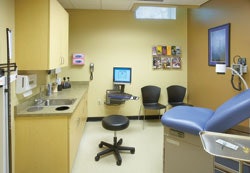 PATIENTS ARE A VIRTUE Wartburg College's Waverly Community Wellness Center accommodates patrons seeking medical attention.
PATIENTS ARE A VIRTUE Wartburg College's Waverly Community Wellness Center accommodates patrons seeking medical attention.That said, all design decisions require prudence. As stated earlier, healthcare facilities have more mission-critical operations affecting personal privacy than do recreation facilities, and that fact should influence building design. While high visibility can increase attention, it doesn't necessarily mean that student health should be located right inside the recreation center's front door. The "see and be seen" mentality when working out doesn't translate to walking into a counseling session or receiving outpatient treatment for flu. In reality, the vast majority of students show up for sore throats and routine exams, but with proper planning of the facility, its entry sequence and traffic flow, the sensitivities of health center patrons can be well accommodated.
Within the recreation center, cross-training sessions are easily enhanced when student healthcare and wellness education is incorporated. Consider the potential benefits of facilitated workouts and group exercise classes when they offer a clear focus on proper technique while providing health information from medical personnel. This holds the potential to improve not only student education, but also participation, thanks to a more diverse programming menu.
In addition, there are many business intricacies to consider when combining student health and recreation under one roof. Like most commercial ventures, a solid business plan is essential. Attention must be paid not only to the suitable location of each tenant, but also related costs, departmental differences and overall space demands. Beyond the capital investment involved in building new or relocating existing student health operations, the issue of cost is minimal since few if any new operational hurdles will be encountered in a new location. Turf wars between the recreation and health departments are possible, but can be mitigated so long as the overarching focus remains on student well-being as it relates to maximum opportunity and success.
More institutions than ever are building student recreation centers that include a full slate of health services in an effort to maximize the student wellness experience and further improve overall quality of student life. Missouri Southern State University opened just such a facility last month. Darren Fullerton, director of student life and dean of students, says that combining resources allows MSSU to offer many programs that were previously unavailable. "We know that our combined staff in health and rec will be very good for the students," Fullerton says.
Further evidence of this mind-set emerged in the 2009 Athletic Business Architectural Showcase. Of 22 projects identified as collegiate student recreation facilities, five include significant student health centers (see "Showcased," below). This is more than a flash in the pan; it may soon represent the norm as to how student recreation and health services are packaged.
Merging departments and people of like mind brings great value to the already highly regarded collegiate student recreation center. As the American College Health Association summarized in its "Healthy Campus 2010" initiative, "Advancing the health of college students influences the quality and productivity of their lives in the workplace and in the community." If planned properly, recreation and health mergers enrich the campus fabric and society as a whole - a healthy relationship, indeed.
 Benefits of Regular Exercise
Benefits of Regular ExerciseGet Smart
Health education opportunities afforded through student health and recreation collaboration:
|
|
SHOWCASED
Student recreation centers appearing in AB's 2009 Architectural Showcase that included student health centers











